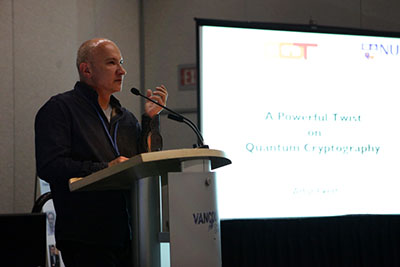Nov 5 2012
Quantum cryptography is the ultimate secret message service. Research published 18 October in Physical Review Letters shows that it can counter even the ultimate paranoid scenario: when the equipment or even the operator is in the control of a malicious power.
 CQT Director Artur Ekert told delegates in February at the 2012 AAAS Annual Meeting that quantum cryptography can not only resist eavesdroppers, but even a loss of free will. He was presenting research carried out with Dax Koh, Michael Hall, Valerio Scarani, Setiawan, Alastair Kay, James Pope and Chiara Marletto, now published in Physical Review Letters.
CQT Director Artur Ekert told delegates in February at the 2012 AAAS Annual Meeting that quantum cryptography can not only resist eavesdroppers, but even a loss of free will. He was presenting research carried out with Dax Koh, Michael Hall, Valerio Scarani, Setiawan, Alastair Kay, James Pope and Chiara Marletto, now published in Physical Review Letters.
Previously, quantum cryptography protocols always assumed that an adversary would not have access to information about any choices that are made during the process of encryption. "We are challenging this assumption," says co-author Artur Ekert, one of the inventors of quantum cryptography and Director of the Centre for Quantum Technologies. "We are asking well, what if you are controlled?".
Artur presented this research to a general audience at the Annual Meeting of the American Association for the Advancement of Science in Vancouver (news story), held in February 2012. This text is based on the media release prepared for that event.
From ancient Rome to the modern age, most classical schemes for cryptography have relied on the 'decoding' step involving some problem that is hard to solve — but hard, rather than impossible. That has left cryptographic schemes, including those in wide use today, vulnerable to clever people or advances in technology.
Quantum cryptography, by contrast, offers security protected by the laws of physics. The technique provides a way for two parties to share a secret key — a random sequence of 1s and 0s — which can then be used to scramble a message. The security comes from quantum laws providing a built-in way to detect eavesdropping attempts. When the key is transmitted, using photons, say, any interception of the signal changes it in a way the legitimate parties can detect. Insecure keys can then be discarded.
But a 'malicious manipulator' might have the ability to control the setup or influence the communicating parties' choice of settings in transmitting the key. The manipulation could even be something enshrined in fundamental physics — a limit on the amount of free will that humans can exercise.
It's a huge challenge to face, but the researchers believe quantum cryptography can still sometimes triumph. Artur and his colleagues have worked out how to calculate, given the degree of manipulation, how much genuine 'randomness' remains in the key. This offers a measure of how much of the key has been left untouched and will, in turn, determine how much of the key can be guaranteed secret.
The work was led by Dax Koh, a scholar with Singapore's Agency for Science, Technology and Research (A*STAR) working at CQT, and Michael Hall of the Centre for Quantum Dynamics at Griffith University in Australia. Others involved in addition to Artur are Valerio Scarani of CQT and NUS, Setiawan of NUS, Alastair Kay of CQT and the University of Oxford, and James Pope and Chiara Marletto of the University of Oxford. Artur is Lee Kong Chian Centennial Professor at NUS and Professor of Quantum Physics at the Mathematical Institute, University of Oxford as well as Director of CQT.